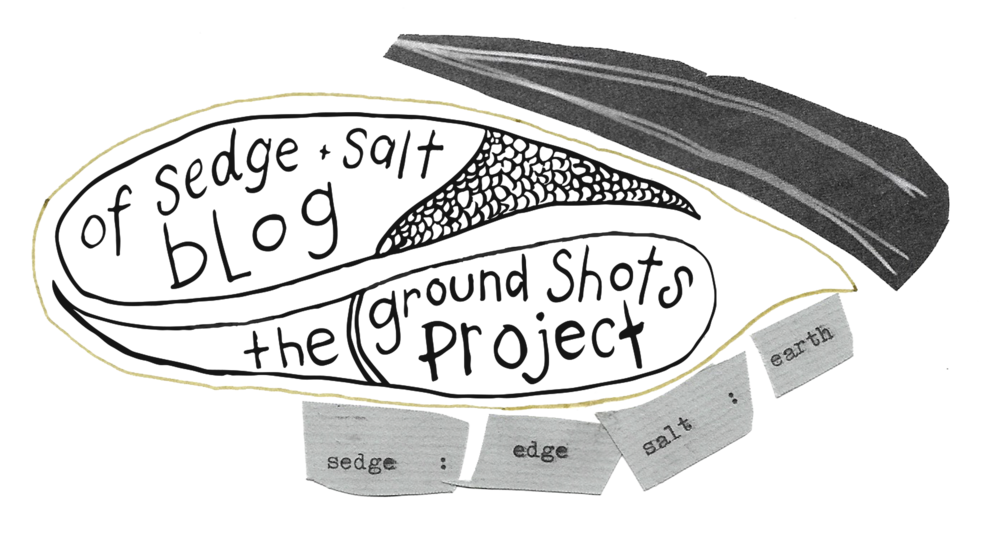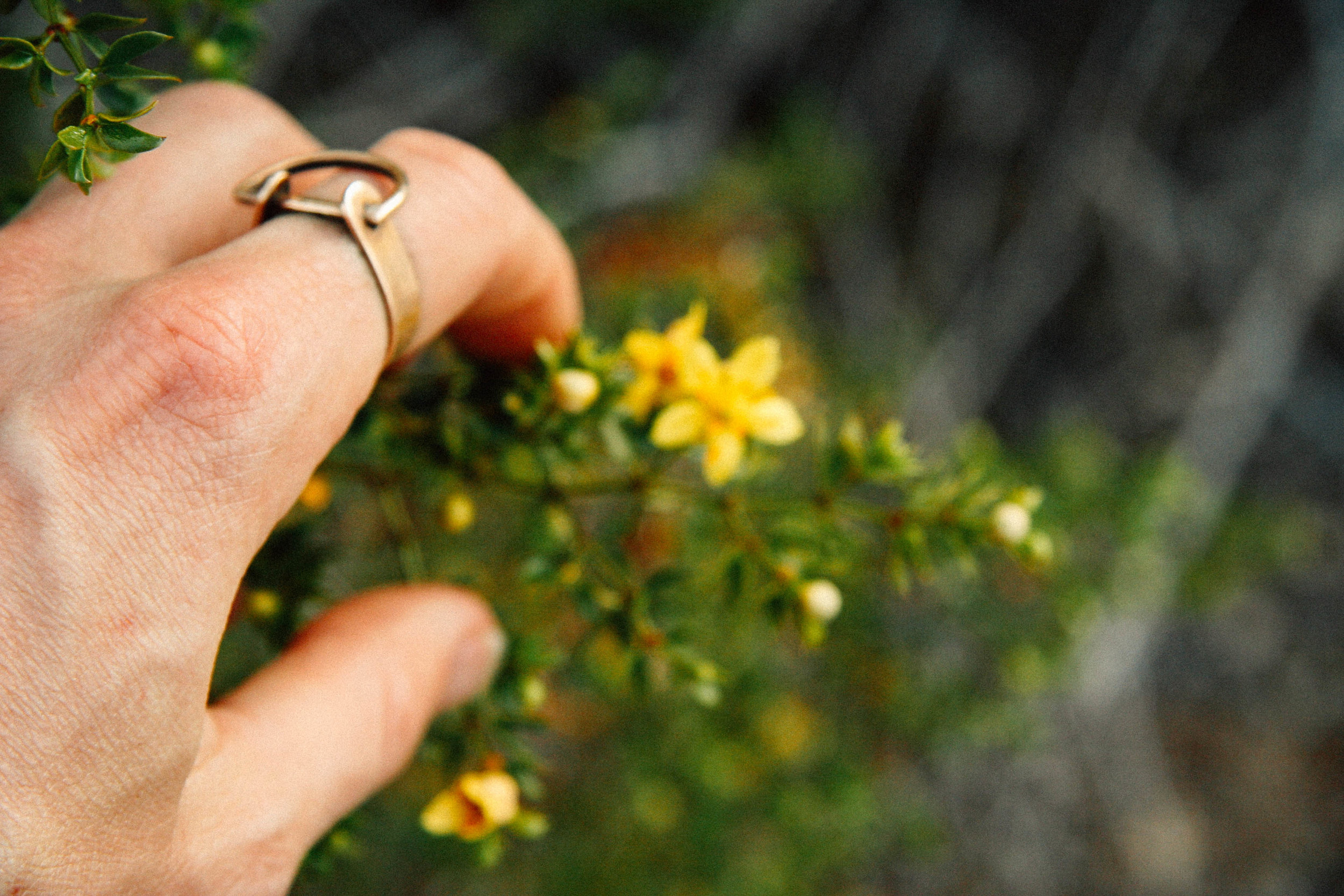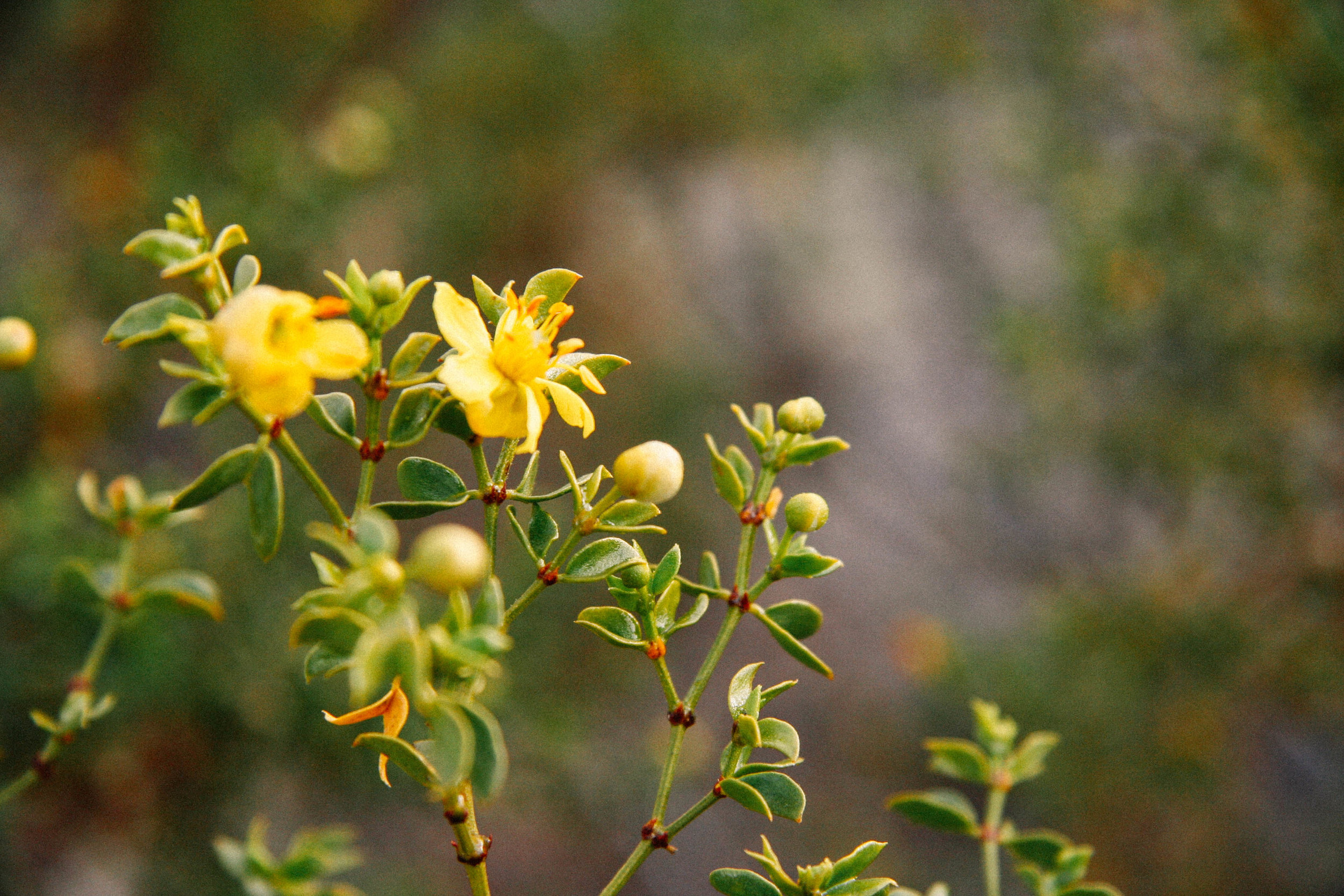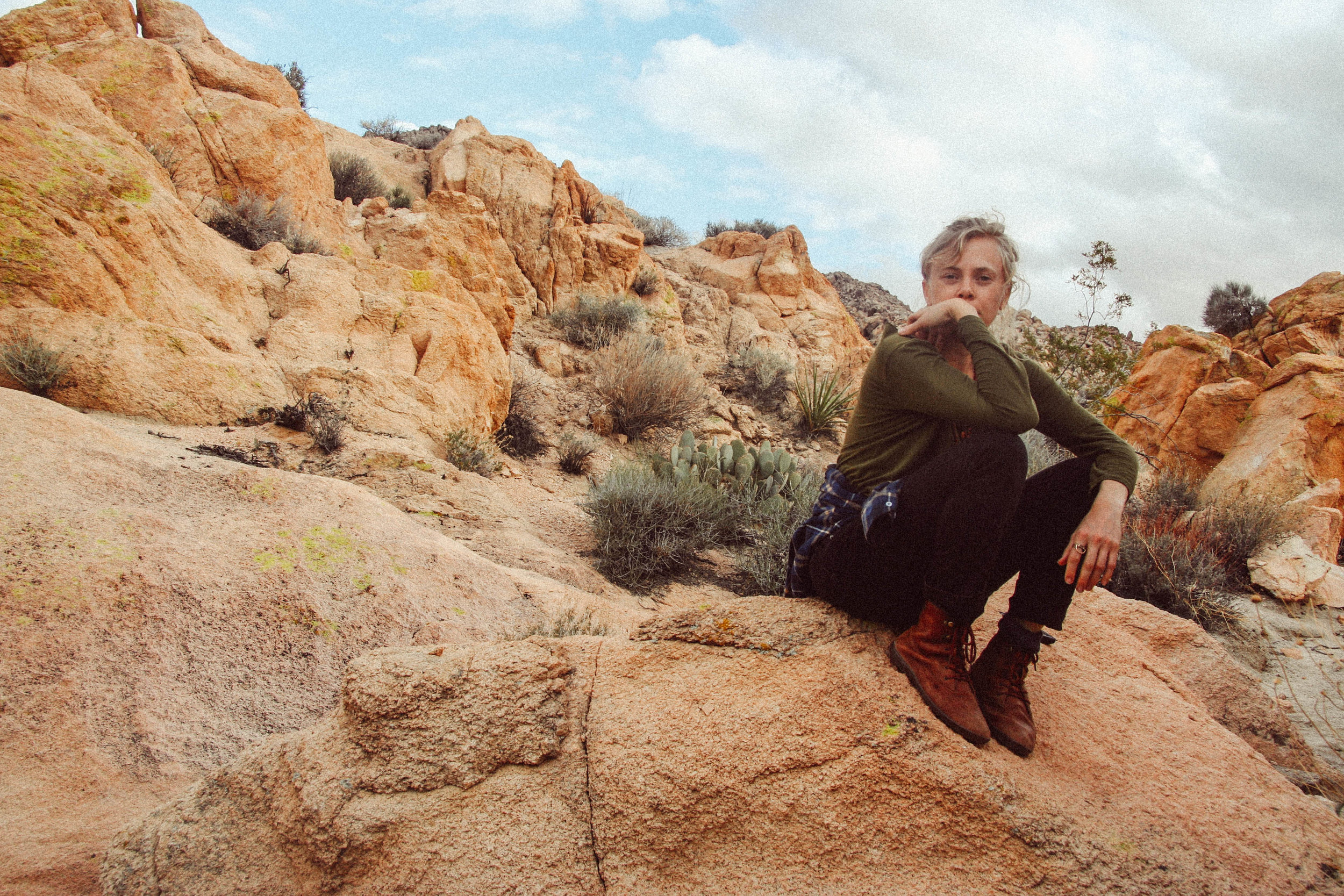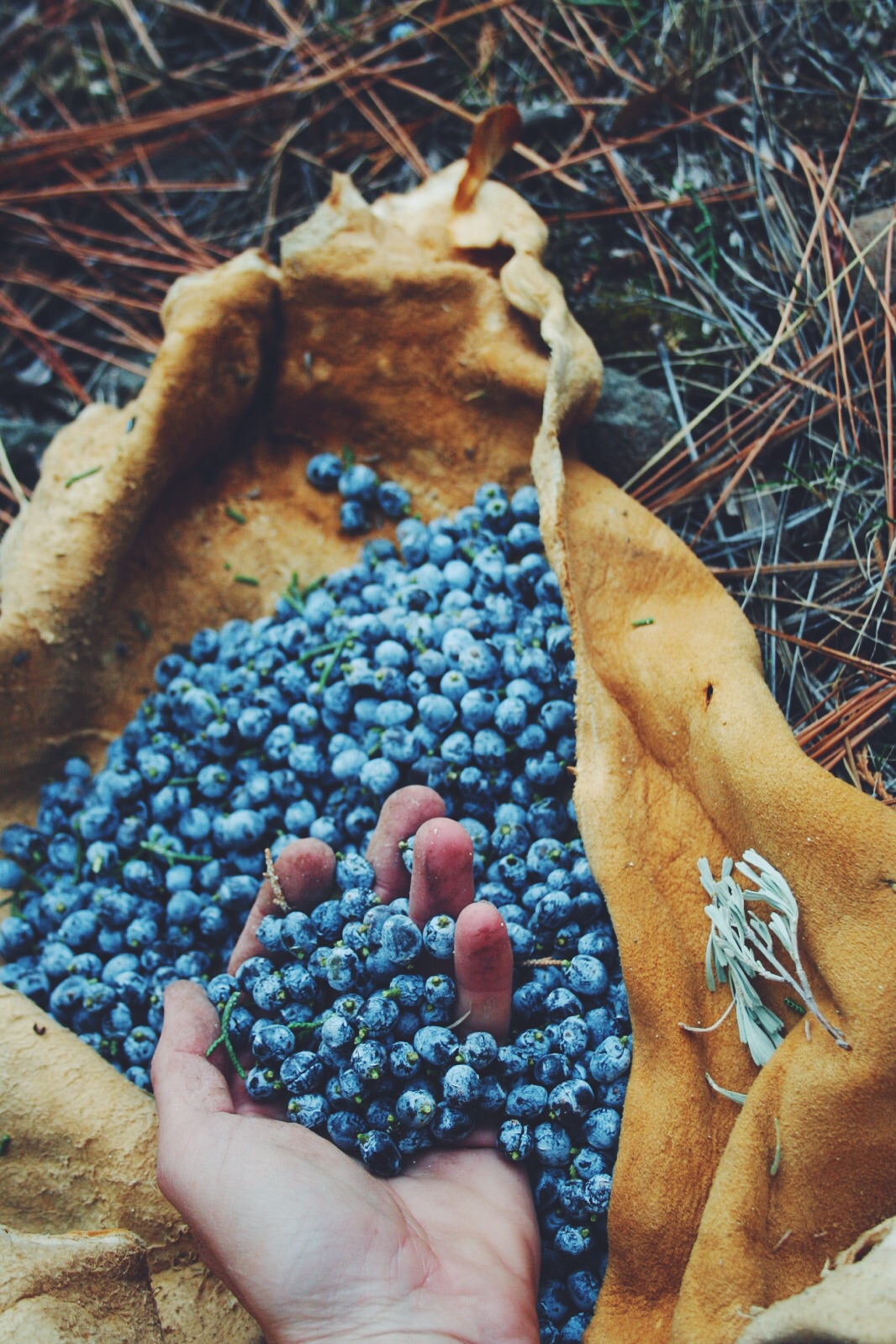Larrea tridentata near Joshua Tree, CA 2018.
Intro to Creosote Bush / Chaparral / Greasewood / gobernadora : Larrea Tridentata (Zygophyllaceae) and ecology
Yatamp, yatampi, ya'tam'pi (Paiute)
Yatumbi (Shoshone)
( Names according to research in "Native Plants of Southern Nevada: An Ethnobotany" by David Rhode, cited at the bottom )
Creosote Bush is found in the Mojave, Chihuahuan and Sonoran deserts centralizing in the Southwest and into Mexico. It covers miles of terrain, sometimes creating a sea-like illusion on the desert floor much like Sagebrush does in the cooler Great Basin desert to the north.
Creosote Bush is commonly named as such because this plant's heavy resinous scent and tacky demeanor has been compared to the smell of creosote found in stove pipes. It doesn't really smell like black soot at all to me, but does indeed have a sweet and musty smell that especially fills the air after rainstorms when it opens it stomata and on cool mornings in the desert where it grows. This plant is also sometimes called Chaparral, possibly because of its scrubby and tangled appearance. This growth style slightly resembles some of the plants that grow in varying incarnations of the mediterranean Chaparral ecological community that is located mainly in California. This ecological community (or set of communities because there are variations) doesn't actually include Larrea at all but mostly species of Manzanita (Arctostaphylos spp.), Ceanothus, Oak (Quercus spp.), and more. And Creosote Bush when called its other common name Chaparral is not to be confused with Chaparro Amargosa (Castela emoryi) which is an endangered plant due to development that also grows in some of the same deserts as Creosote Bush. Creosote Bush is called 'gobernadora' in Spanish which translates as 'the governess' or 'she who governs' possibly due to Creosote's sense of ruling over the desert lands where it grows, and also due to some of its survival strategies. It often is the dominant plant for miles. (Creosote Bush, Larrea or Chaparral, from here on out will be used to describe Larrea tridentata)
Larrea is also incredibly efficient at reserving water for itself due to harsh temperatures and long periods without rainfall in the desert. As with other plants that have resinous leaves, Larrea's are adapted to retain precious water for its photosynthetic needs. The resins protect the plant from the harsh environment, and it is these concentrated powerful resins that give the plant its greatest medicinal qualities. Mature plants are extremely tolerant of drought. Rising temperatures and recent droughts in the Southwest have actually increased its populations because of this plant's adaptability. When it does rain, the plant takes as much opportunity as it can to absorb the moisture, and the leaves and new branches almost feel succulent to the touch. When it is hot out and hasn't rained for awhile, you can approach one of these bushes and think that it is practically dead- even the newest of branches will break off with clear tree-limb like 'snap.'
Yes, Creosote Bush is a woody shrub, with its thin branches bearing black rings here and there from past growth (see photograph directly below). This plant mostly retains its small precious leaves year-round, with some sprinkling of loss that actually forms a special habitat for other animals in the littering on the ground. The leaf color is usually a darker olive green, though during rains, it can brighten up substantially. In early Spring, it starts to produce its bright yellow 5-petaled flowers. (Many of the photos throughout this piece are from my recent trip to Joshua Tree, California this past winter, and were taken right after a rain.) A pollinated flower turns into a silvery-fuzz ball of seeds that may germinate plants, but because of the drought, many do not survive through initial growth.
An interesting bit of information from an in depth scientific study on the plant:
"It is believed that the creosote bush originated in South America and spread to North America some millennia ago. In some arid regions of southwestern USA, the plant not only thrives as the most dominant vegetation but has also genetically adapted as evidenced by genotypes that vary according to regions. The plant grows in all desert regions, but only the species that grow in South America and in North America's largest desert (the Chihuahuan) carries two sets of chromosomes in each cell nucleus. In the Sonoran desert, where winters are mild and rains fall during both the summer and winter, the plant has four sets of chromosomes. By contrast, in the Mojave desert, the smallest and driest desert of the USA, where summers are very long and hot, the plant is hexaploid.7,8Whether the chromosomal variations are in response to the climate of the region or correlate with the quantity and diversity of the production of secondary metabolites is unknown. There is considerable pharmacologic interest in these metabolites, which the plant appears to use for defense." (Gnabrea, Bates and Huan, Creosote bush lignans for human disease treatment and prevention: Perspectives on combination therapy)
Like the Aspens mentioned in our Populus plant profile, Chaparral can reproduce clonally after parts of itself dies. Because of this reproductive strategy, these are some of the oldest organisms on earth. Curiously, some of the other oldest plants include the Bristlecone Pine which grows in the Great Basin desert near the oldest Aspens, Figs and Olive trees in Europe and Asia, some Eucalyptus groves, Yew and Cypress trees and more. Check out a list here.
Larrea tridentata near Joshua Tree, CA 2018.
Uses and Lore
Given that Creosote is the 'Governess' ecologically, it is no surprise that it has been revered as a plant with a wide range of uses for everyday life by the native folks who have lived intimately with the plant for 10-14,000 years. The book 'Native Plants of Southern Nevada : An Ethnobotany' was funded by the U.S. Dept. of Energy and in collaboration with local native tribes in order to determine if a possible nuclear waste storage site (Yucca Mountain) had any cultural or ecological significance. What was produced from the project was an invaluable (but far from complete) compilation of plants and their importance for various native tribes in the area and in the broader region they are found, as an effort to highlight how important the land is to the native people that (still!) live there. Creosote Bush is one of many plants featured, and the book is the source of where I got the various native names for the plant. The book mentions the plants' importance for use in tool making and shelter building especially in a place without a lot of wood or materials for building to create shade. A glue-like resin that leaks from the plant sometimes was used in scenarios where something needed to be held together- like with pottery or baskets.
It can be used as an added preservative in medicine making to keep oils or salves from oxidating. A couple twigs can also be added into food storage areas to keep moisture away.
Consult Creosote for when you need grounding. It is powerful added to a bath, as an oil on the body after a wind storm, extreme sun exposure, stuck in traffic, a long hike or crazy week.
Medicine of Larrea
Though the FDA claims to be cautious about using the plant, mostly internally, due to a scientific study that yet again isolated one compound from the plant and fed mice only that compound for days, resulting in kidney and liver damage. Although, there continues to be some research done due to the pharmaceutical industry's interest in the plant, or for its possible use as a preservative on an industrial scale. I think the situation is more complex than just not using it because of one study. The plant has a kind of power to decide to help you or not. It has the capacity to ward off infections like staph, which I have seen in action while helping 7song at the Rainbow Gathering years ago doing first aid, and in many other first aid scenarios. Like with my dad's use of the salve for his over-sunned face working outside with no protection, the plant has a capacity to mend places externally on the skin that could learn towards abnormal. I am not saying it is a 'cancer cure' because not enough research has been done, but the plant has shown the capacity to help in those scenarios when it wants. I took a class this Spring at the Good Medicine Confluence in Colorado focused just on this plant alone, and one person chimed in during class who has studied with a native elder (I can't remember which tribe!) and said that the plant is just that- it could give you everything you need or harm you if you do not have the right intention. I also feel that small doses of the plant in acute situations when needed are likely to not be harmful.
I have also seen it help to clear cysts internally, specifically with a friend. The doctor had recommended she do an invasive surgery to remove the cyst, and she opted to try this plant internally first to see if it would help. The doctor was amazed and also a little angry unfortunately that this person worked with plants instead of opting for surgery to clear the benign cyst. I would recommend working with an experienced herbalist, naturopath, osteopath, Chinese doctor or acupuncturist if you're wanting to clear a cyst using non-allopathic methods.
Larrea tridentata near Joshua Tree, CA 2018.
The plants' medicine is broad reaching and complex. If you want to try to read through the long scientific study I cited in the paragraph above, you will see evidence that it could be helpful for treating HPV and HIV, as well as working with herpes and fungal infections. Both herpes and fungal infections I have experience with using this plant. I have gotten 'Herpes I' outbreaks on my lips since I was a young child and the outbreaks are painful and embarrassing and usually happen when I get stressed, too much sun, drink too much coffee or alcohol, or didn't get enough sleep. The virus wakes up and starts to reproduce, forming a painful blister I can't stop thinking about because it is on my face. Creosote infused in oil or in a salve, I use in conjunction with St. John's Wort and Garlic oil, among other herbs, and apply it to the blistered site throughout its cycle. The healing time and size of the outbreak has lessened though I tend to be getting them more often lately, possibly from the stress of travel. As for fungal infections, I have personally used it on moist feet during rainy Appalachian summers, and on vaginal yeast infections. It's anti-inflammatory effects are helpful during the healing process of working with these varying ailments and imbalances.
Both scientific studies and the ethnobotanical information available on the plant suggest that native folks did historically and still do use the plant for a number of ailments including: as a mild sunscreen or after sun care to prevent free radical damage, chicken pox, eczema, sores (like the kinds my dad gets from the sun, and probably includes staph and the like), measles, as a styptic (powdered to stop bleeding), for burns (like my friend's face burn), during colds and flus, as a mild expectorant, cramp relief, rheumatism and more. You can see why it is an ideal first aid plant, and why I would jump a fence to get some to use for medicine (see my Sagebrush Salve stories blog post on my first time meeting this plant with 7Song in New Mexico in 2012).
An excerpt from the story:
My first experience with this plant was when I gave an seemingly unruly and black jean clad herbalist named Sevensong a ride across New Mexico from the formerly Traditions in Western Herbalism Conference to the Anima Sanctuary in the Gila National Forest in 2012. { ... } Mario, who was Sevensong's apprentice at the time, and Nina, who I had just lived and worked with at the Goldenseal Sanctuary in Ohio the following Spring, took off together for a 24 hour straight ride to arrive at the conference at dawn when first classes began. Fast forward to after the conference and Sevensong and Mario were invited to come out and visit Kiva, Wolf and then Loba- so Nina and I came along because we were the ride. Mario was adamant about getting Chaparral. Given that Sevensong focuses so much on first aid, he was a good passenger to have on the trip. [...} Chaparral is a commonly used and important plant for wounds and infections of the like. I had never seen it so I didn't know what we were looking for at the time. { ... } Sevensong kept his eyes peeled for vast fields of the scrubby plant and after hours of windmills and immensity, he spotted it. Over a barbed-wire fence and up a big hill. We pulled over and got our bags out, and made our way towards the fence, ominous storm clouds drifting around right on the other side of the bare hill. We awkwardly hopped over or climbed under, getting covered in dry desert dirt. Walking up to the plant, I could hardly believe this thing was even alive.
One crack of a gnarly limb and holding it up to my nose sent a profound waft in the air- the smell of pure solitude, of harsh sunshine, of dry survival. Quietly for nearly 45 minutes we collected the twigs for later oils and tinctures."
This past winter I got a UTI for the first time in years from getting dehydrated, sitting a lot, stressed out and tired from driving all day in the desert. For the next week, I was in the land of Creosote Bush, and wanting to try my best to ward off the infection instead of using antibiotics. Some friends suggested a strong decoction of this plant internally as a slight diuretic and anti-bacterial for the bladder. I drank it for a few days but eventually I couldn't keep it down, as the tea tastes HORRIBLE. It is hard to drink. I feel like it worked okay, but wasn't what really did the job for the infection, which never got full blown bad. Later, I stopped the internal tea mostly, and switched to a tea blend made by my desert herbalist friend Peri Lee. Somehow I had landed at the right person's house during that ordeal. Maybe Creosote Bush works for UTI's for some folks, and it seems to be historically used that way to an extent. But, folks who have worked with the plant for awhile say that there might be better less harsh alternatives out there.
I wouldn't turn to it for the ultimate 'cancer remedy,' but I wouldn't disregard it for that use either. I have a feeling some patented drug will come out isolating compounds from this plant for that use at some point, we'll see how it the movement of that exploitation progresses.
Over the years I have made a toothpowder (it was in my first land capsules!) that contained Larrea for its anti-microbial qualities. I'll have some more for sale, eventually.
Larrea tridentata near Joshua Tree, CA 2018.
Harvesting
Though the aerial branches in entirety would be useful medicinally in the many ways cited already, the best practice for having a balanced impact on the plant would be to harvest carefully. I say balanced because, many plants thrive more from pruning and disturbance, and others do not. So balanced in this case would be to try to harvest the less woody and younger parts of the plant first. After a rain this past March when visiting Joshua Tree for awhile, I wandered to a dry wash my friend suggested, early in the morning. It was a rare cloudy day, and the birds by the wash were building homes in the cholla out of the neighbor's trash, dog hair from brushings, as well as from wool and other organic matter found who knows where. An avenue of these intricate shelters formed in the shielding spikes of desert sharpness led me down sandy steps that gradually landed me towards the bottom, where the wash had last swollen with water, probably not this season due to drought. Nonetheless, the recent rains has swollen the Creosote branches, and offered new growth to these tough trees. I trimmed just the far edges of the bushes, taking turns from one bush to the next, seemingly spaced like a garden planted. This seemed so with enough room for everyone to thrive- at least that's how the Creosote tends to arrange itself through its own magical methods. I took a paper bag full of these succulent resinous cuttings of leaf and new non-woody branches and a few days later chopped it and put it in oil. One day I'll powder some for a first aid kit or more toothpowder.
: Joshua Tree desert scenes :
Larrea tridentata near Joshua Tree, CA 2018.
Drawing Larrea tridentata near Joshua Tree, CA 2018.
Works Cited
Wikipedia. Larrea tridentata. Web. accessed June 1, 2018. https://en.wikipedia.org/wiki/Larrea_tridentata
Elpel, Thomas J. Botany in a Day : The Patterns Method of Plant Identification. 6th edition. Hops Press. Pony, MT: 2013.
Moore, Michael. Medicinal Plants of the Desert and Canyon West. Museum of New Mexico Press. Santa Fe: 1989. (Frank Cook's copy)
Rhode, David. Native Plants of Southern Nevada: An Ethnobotany. The University of Utah Press. Salt Lake City, Utah: 2002.
Blackwell, Laird R. Wildflowers of the Eastern Sierra and adjoining Mojave Desert and Great Basin. Lone Pine Publishing. Edmonton, AB, Canada: 2002.
Clark, Charlotte Bringle. Edible and Useful Plants of California. University of California Press. Berkeley: 1997.
Stuart, John D. and Sawyer, John O. Trees and Shrubs of California. The University of California Press. Berkeley: 2001.
Tilford, Gregory L. Edible and Medicinal Plants of the West. Mountain Press Publishing Company. Missoula, Montana: 1997.
Gnabrea, John & Bates, Robert & Huang Ru Chih. "Creosote bush lignans for human disease treatment and prevention: Perspectives on combination therapy." Journal of Traditional and Complementary Medicine. Vol. 5, Issue 3, July 2015, pgs. 119-126. https://www.sciencedirect.com/science/article/pii/S2225411014000388
